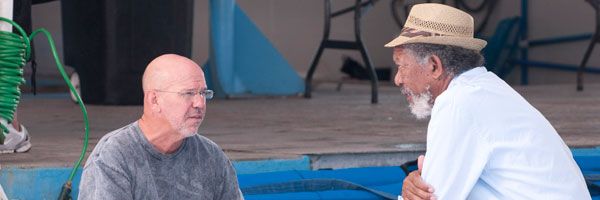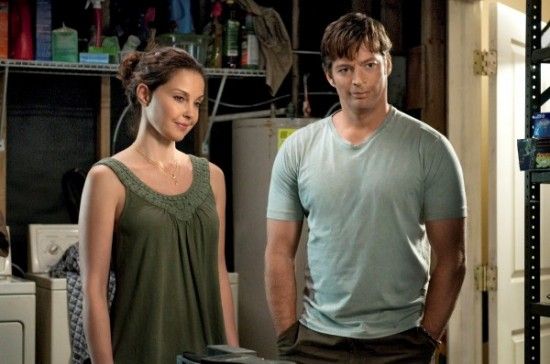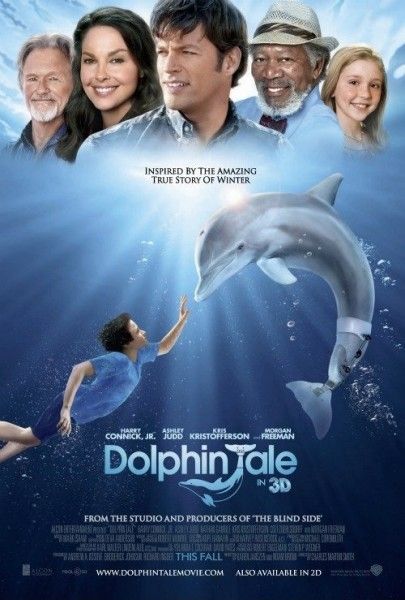Dolphin Tale is inspired by the remarkable and amazing true story of a dolphin named Winter and the people who banded together to save her life. As a young dolphin, she was caught in a crab trap, severely damaging her tail enough that she ended up losing it. With the expertise of a dedicated marine biologist (Harry Connick, Jr.), a brilliant prosthetics doctor (Morgan Freeman) who wasn’t willing to give up, and the devotion of the young boy (Nathan Gamble) who discovered her, the story becomes a heartwarming adventure about the healing bonds between human and animal, and it illustrates how hope and courage can get you through almost anything.
During this exclusive phone interview with Collider, director Charles Martin Smith (also known for his acting work in such films as American Graffiti, The Untouchables and Starman) talked about the affect that meeting Winter had on him, the importance of not overdoing the sentimentality inherent in the story, that he wanted to capture Winter’s true personality for the film, how his acting background helped him in working with his young leads, his reasons for shooting the movie in 3D, and his hope that the film leads people to realize that, by helping others, we truly help ourselves. Check out what he had to say after the jump.
Question: How did this come about for you? Had you known anything about this story?
CHARLES MARTIN SMITH: No, actually. Alcon had heard about Winter and had begun to develop this screenplay. I think they had been working on it for a couple of years, and the project was just stalled there. It didn’t look like it was going to be made. But, they wanted to take one more try, so they called me and asked me if I would come in and get involved. That was the first that I had ever heard of it. They actually flew me in to meet Winter and I was blown away. I was amazed when I heard the story, but then to actually meet her and see her prosthetic tail and to meet all the people there was fantastic. I started working on writing a new draft of the script, which I worked on for almost nine months.
What impression did the experience of meeting Winter leave you with?
SMITH: It’s hard to say. The one thing that you do see about her is that she has absolutely no quit in her. She is an optimistic, very intelligent, very mischievous, wonderful, bright, juvenile animal who has a lot of lessons to teach about perseverance. She has this wonderful spirit. The fact that she can barely swim is something that you’d never get the feeling has gotten her down or that she’s ever been depressed about it. To see how inspiring she is for people around her meant a lot to me. During those nine months when I was writing, I actually went to the Clearwater Marine Hospital three or four times, just to spend time there, and I got the chance to swim with Winter too. I went in and spent a lot of time in the water with her and got to know her. I just thought, “This is one of the wonderful things about film. When on earth would I ever form such a close bond with a dolphin?”
When you’re doing a film that’s based on a true story, is it more important to you to stay true to the heart of the story, rather than making sure every single fact is accurate?
SMITH: Absolutely, yeah! In this case, the business about her losing her tail and the prosthetic, and all the science involved, is true. But, the kids and some of the other characters is all added in. It’s a mix. It’s inspired by a true story. It’s not completely accurately based on it, but I think it keeps the spirit of it. I like the fact that there are kid characters. I think that does, in fact, help kids to connect with the story more. And, there’s a wonderful little film about child empowerment and self-empowerment that I also liked. The kids gave it something that I wanted to bring to it, which was a little bit of a slight fantasy element and a little bit of magic. I wanted to make the marine aquarium a slightly magical place with a funny pelican that is around, and where Hazel and her dad live on a houseboat, and she has her own crow’s nest, and she goes up into the roof, and people can swim with their dolphins, and the kid flies his own helicopter, and that the kids can put on this carnival at the end. I wrote all those things in because I wanted there to be a slight air of magicality to it. I wanted to do it so that you were seeing the whole story through the eyes of a child. But then, in order to keep it from becoming too ridiculous, I wanted to ground the characters and make sure that the kids were absolutely real, and acted like real kids and responded to things the way real kids do. I hope that I was able to do that, both in the writing and the directing.
How did you find the right balance of the sentimentality in the film?
SMITH: I always thought that you have to be really careful with a film like this, to keep it honest and not allow it to get sentimental or silly or maudlin. It’s inherent in the story. This dolphin is going to die because she lost her tail and she needs this prosthetic. You don’t need to trump it up anymore. You don’t need to overdo it. The only scene that I thought I might have gotten a little bit more sentimental than I needed was the final tail try, when she finally swims. But, people at test screenings said, “No, at that point, we’re right into it and right along with it.” At that point, you can accept a certain amount of it.
Did your past experiences working with animals help you with this at all, or is there really no way to prepare for working with a dolphin?
SMITH: I’ve worked with animals before and it helps that I’ve been an actor, to some degree, because, in the way you edit the animal together, you can create a performance. I had a very good editor, Harvey Rosenstock, who is good with performances. Among others, he cut Scent of a Woman, which is a masterfully acted movie. So, when the dolphin does various things, you can piece it together and build a little bit of a performance, just in how you edit it. It helped me to be able to do that. It was very important to me that Winter only do in the movie what Winter really does. I wanted the kids to be real kids, and I wanted her to be a real dolphin. Everything that she does in the movie are things she really does. Not of that is stuff that was taught to her to do.
Was it challenging to convey the personality of Winter, or is it something that inherently comes through with her?
SMITH: It’s something that comes through with her. I was so surprised about that, when I first met her. She really does have a great personality. When I was starting my research, before I started writing, I learned that she has this blue mattress that she loves to jump up on and float around on. She also makes this tweety bird sound, all the time, that’s this little high-pitched tweet. That’s her signature thing, so I wanted to put that in the movie. That does give her personality. She really is funny. Sometimes, she’ll just float around on that mattress and it will be time to put on the tail and she won’t do it. She’ll just pretend she didn’t hear you, and you know darn well she heard you. She’s like a kid. Sometimes she’s a little bratty. I wanted to capture all that and put her on screen the way she really is.
What was the casting process like for finding your two young leads, Nathan Gamble and Cozi Zuehlsdorff?
SMITH: I was so happy to find those two kids. Our casting directors, Kerry Barden and Paul Schnee, just put out a massive casting thing online and across the country. I must have personally seen close to 200 kids for each role, and spent a long time auditioning kids and looking at tapes, to find the right two kids. Nathan had done a bunch of films before. He lives in Seattle and I actually auditioned him up in Vancouver. And then, little Cozi had never been in anything except community theater in Orange County. It helps that I have such a strong acting background because I know what I’m looking for, I know what the needs are, and I know acting when I see it. And, that girl is a one in a million talent. She is a really talented kid. Both those kids are. And, they’re great kids. They’re just wonderful children.
How did you end up rounding this cast out with such well-known names as Morgan Freeman, Ashley Judd, Harry Connick Jr. and Kris Kristofferson?
SMITH: We had the usual meetings that you have beforehand, talking with the producers about who could be in it. We all thought Harry Connick would be a great idea, and we thought Ashley Judd would be a terrific idea, so we offered them the roles and they said yes. I was floored. I was like, “Really?! You guys really want to do this movie?” But, they just fell in love with the story, once they learned this was real. The same thing happened with Morgan Freeman. Quite honestly, there were some discussions of, “Well, if Morgan says no, who do we go to next?,” but he said yes. We were just overjoyed. And, he had the same response. The first day he came to the set, the first thing he wanted to do was walk over and meet Winter, nevermind the director. He already knew Ashley. He had worked with her before. So, he was as moved by Winter as anyone.
Since it wasn’t initially your idea to shoot this in 3D, what was it that finally sold you on it, and what do you think it adds to the experience?
SMITH: It was something that came up in conversations with myself and the producers. It was a thing where 3D was becoming popular and much easier to do. We just thought, “Wouldn’t it be cool to use the 3D to pull the audience underwater, as it were?” In the opening of the movie, when we meet Winter and her pod, all swimming out in the ocean, and in the scenes where the boy is swimming with the dolphin underwater, you feel like you’re right in there with them with the 3D. That is what is very, very cool about it. That was what was exciting about using 3D as a tool here. It helps the audience feel like they’re having the experience, to the greatest degree.
What message or theme do you hope audiences will take with them, after seeing this film?
SMITH: Well, the main thing I want them to take away is that they just had a rollicking good time. I just hope they really enjoy it, have fun, and find it emotional and uplifting. But, I would also love it if kids come away from this thinking something like, “What’s our place on this planet? What is our obligation to nature and the other animals on the earth?” It’s important to me to emphasis that the marine hospital in the movie, and in real life, has a mandate of, “Rescue, rehab and release.” Poor Winter will never be able to live in the wild without a tail, but whenever possible, these animals should be released. With the wonderful work that these people are doing, I hope people come away from this movie really thinking about that. There’s also a sense that, by helping others, we make ourselves better, and by helping others heal, we heal ourselves. I think we can do that on an individual level and a worldwide level. I hope people have a chance to give that a little bit of thought.
Do you have any idea what you want to do next? Does doing something like this and having this kind of experience affect where you want to go next with your career?
SMITH: It does, sure. I want to make films that are worthwhile, on some level, but also very entertaining, and I hope that I’ve managed to do it with this. I don’t know about next. I just finished this a few weeks ago, to finally deliver the last print with the final color timing and the look of the film, so I don’t know. Once this is out, I’ll start to regroup and think a little bit about what to do next.
When you were working as an actor, did you always have the goal of transitioning from acting to directing, or was it something that developed along the way?
SMITH: A little of both. When I was in university studying acting, I was actually transferred over to being a directing student. My big interest, when I was in university, was in the theater. I wanted to direct plays. I pictured myself directing Broadway plays someday. So, the idea of directing was something that I always had in the back of my mind, and writing as well. I began to write screenplays when I was in my 20's. But, it was probably not until after I did Never Cry Wolf, where I was also one of the writers, as well as the leading actor, and worked so closely with Carroll Ballard, who is a great director, that I began to really think I understood the language of film enough to be able to direct a movie. Then, in my 30's, I just gradually began to do it.



